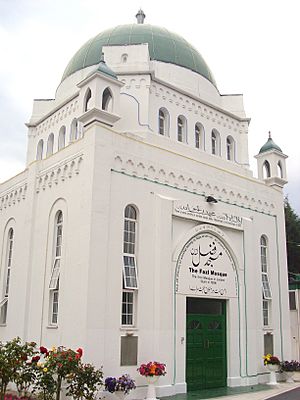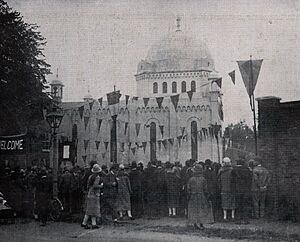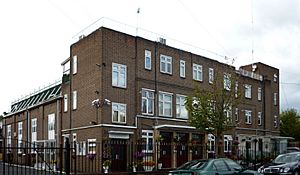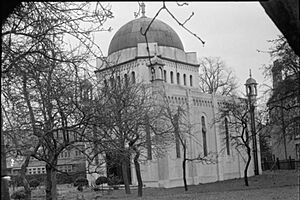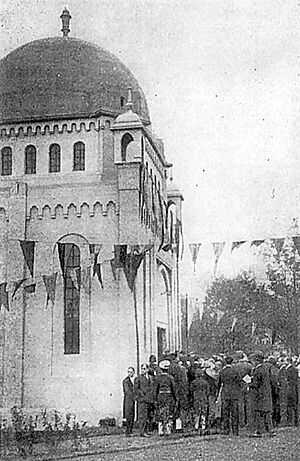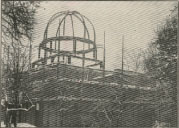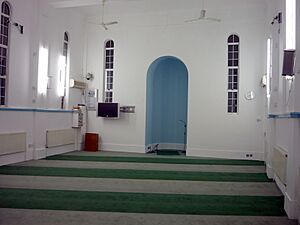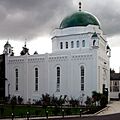Fazl Mosque, London facts for kids
Quick facts for kids Fazl Mosque |
|
|---|---|
 |
|
| Religion | |
| Affiliation | Islam |
| Leadership | Mirza Masroor Ahmad |
| Location | |
| Location | London, England |
| Architecture | |
| Architect(s) | Thomas Mawson |
| Architectural type | Mosque |
| Architectural style | Indo-Saracenic architecture mughal architecture |
| Completed | 1926 |
| Specifications | |
| Dome(s) | 1 |
| Minaret(s) | 0 |
The Fazl Mosque (also known as The London Mosque) is a very important building in London, England. It was the first mosque built specifically for prayer in London. It opened on October 23, 1926, in an area called Southfields, Wandsworth.
Building the mosque cost about £6,223. This money was raised by donations from Ahmadi Muslim women in Qadian, Punjab, which was part of British India at the time. They also got help from a British Muslim named Khalid Sheldrake.
From 1984 to 2019, the Fazl Mosque was the home of the spiritual leaders (called caliphs) of the Ahmadiyya Muslim Community. This meant it was like their main office for the whole world. Now, their main office is in Islamabad, Tilford.
Contents
Building the London Mosque
The design for the Fazl Mosque was created by Thomas Mawson. His plans are kept in an archive in Cumbria.
The first stone for the mosque was laid in 1924 by Mirza Bashir-ud-Din Mahmud Ahmad. He was the second spiritual leader (Caliph) of the Ahmadiyya Community. He was visiting London to represent Islam at a big meeting called "The Conference of Living Religions." About 200 guests came to the ceremony when the foundation stone was laid.
Building the mosque started in September 1925 and was finished just 10 months later. The Caliph named it the Fazl Mosque, which means "The Grace Mosque."
Prince Faisal of Saudi Arabia was supposed to officially open the mosque. However, he was stopped from doing so at the last minute. Even so, the opening went ahead as planned. Khan Bahadur Sheikh Abdul Qadir officially opened the mosque on October 4, 1926. Around 600 important guests from many countries, along with local politicians, attended the ceremony. The event was widely reported in the news.
The mosque can hold 150 people for prayers. Its first prayer leader (Imam) was Maulana Abdul Rahim Dard. The first person to call people to prayer (muezzin) was Mr Bilal Nuttall. Since 1926, the London Mosque has had eleven Imams. The current Imam, Ata'ul Mujeeb Rashid, has been serving since 1983.
Home of the Caliph
In 1984, the government in Pakistan made a law that made it difficult for Ahmadis to openly practice their faith. Because of this, Mirza Tahir Ahmad, the fourth Caliph, moved from Pakistan to London. He temporarily moved the Ahmadiyya headquarters from Rabwah, Pakistan, to the Fazl Mosque in London.
A separate building was built next to the mosque in 1967. It had a hall, offices, and a small apartment on the top floor for the mosque's Imam. When the Caliph moved to London, this apartment became his home. After he passed away in 2003, it became the home of Mirza Masroor Ahmad, who is the fifth and current Caliph. He lived there until 2019, when he moved to Islamabad, Tilford.
Important Visitors and Influence
The London Mosque has welcomed many important people over the years. These include politicians, mayors, scholars, and students.
Muhammad Ali Jinnah, who founded Pakistan, visited the mosque many times. He even gave a famous speech in its gardens. The Crown Prince of Saudi Arabia, Faisal Bin Abdul-Aziz, visited in 1935, as did his father, King Saud.
Sir Chaudhry Muhammad Zafarullah Khan, who was Pakistan's first Foreign Minister and later a judge at the International Court of Justice, lived at the mosque for many years. In July 2011, Prince Edward, Earl of Wessex from the UK visited the mosque. He came to see the mosque's beautiful gardens, which have won many awards. He also saw a small exhibition about the mosque's history. In October 2017, Justin Welby, the Archbishop of Canterbury, visited the mosque. He met with the fifth Caliph, Mirza Masroor Ahmad, to talk about people facing challenges for their religious beliefs around the world.
In 1955, the second Caliph returned to the mosque. He was visiting Europe for medical treatment after an incident in Rabwah, Pakistan. While in London, he also held a meeting for all the Ahmadiyya missionaries working in Europe. The third Caliph also visited the mosque several times.
Growing Bigger
As more and more activities took place at the mosque, they needed more space. This led to the building of the Mahmood Hall and the Nusrat Hall in the mosque grounds. These new halls are used for many things, like Sunday school classes, school visits, question-and-answer sessions, and international meetings. The London Mosque is always busy, helping people learn and understand more about religion.
From the mosque, the fourth Caliph also started the community's TV channel, Muslim Television Ahmadiyya International (MTA), in 1994. Through this channel, he could share messages and his sermons with the Ahmadiyya community all over the world.
The Ahmadiyya Muslim Community has grown a lot, and the London Mosque is now sometimes too small. Because of this, new places were bought in Surrey and Morden, like the Baitul Futuh Mosque. However, the Fazl Mosque still holds a very special place for the global Ahmadiyya Muslim Community and for Britain because of its history and importance.
About the Ahmadiyya Community
The Ahmadiyya Community started in 1889, founded by Mirza Ghulam Ahmad. Ahmad believed he had visions from the prophet Muhammad and announced himself as a reformer of Islam. In 1920, after some missionary work in London, the Ahmadiyya Community and its leader, Hazrat Khalifa Masih II, decided that London was a great place to represent Islam. The Ahmadiyya women in India raised the money to buy a piece of land for the Fazl Mosque.
The opening of the Fazl Mosque was planned to be led by Prince Faisal of Saudi Arabia. However, just before the opening, the Prince said he could not make it.
Mosque Design
The Fazl Mosque has a green dome on its roof, which stands 10 meters (about 33 feet) high. The dome sits on a square base, and there are four smaller domes (cupolas) on each corner of the building.
The mosque's design mixes classic Mughal architecture (a style from India) with British modern styles. It used new building methods and materials, which made it different from older, more traditional "orientalist" mosque designs seen in other early London mosques, like the Shah Jahan Mosque, Woking. Because of its unique blend of traditional and modern styles, the mosque is recognized as a Grade II listed building. The dome is at the front of the current building because the original plan was to extend the front later and have the dome in the middle.
Thomas Mawson's Design
Thomas Mawson and his company, T.H Mawson and Sons, designed the Fazl Mosque. He had studied mosque architecture when he was involved in rebuilding Thessaloniki, a city in Greece. At the time the Fazl Mosque was built, T.H Mawson was known as a top expert in landscape design. Mawson also designed other important buildings, like the Pavilion of Belle Vue Park.
Images for kids
See also
 In Spanish: Mezquita Fazl para niños
In Spanish: Mezquita Fazl para niños
- Islamabad, Tilford
- Ahmadiyya in the United Kingdom
- Islam in the United Kingdom
- Baitul Futuh Mosque
- List of mosques in Europe


